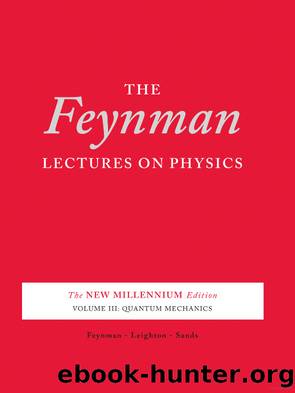The Feynman Lectures on Physics, Volume III by unknow

Author:unknow
Language: eng
Format: epub
Published: 2014-05-19T16:00:00+00:00
12â66 The projection matrix for spin one6
We would like now to use our knowledge of the hydrogen atom to do something special. We discussed in Chapter 5 that a particle of spin one which was in one of the base states (, , or ) with respect to a Stern-Gerlach apparatus of a particular orientationâsay an apparatusâwould have a certain amplitude to be in each of the three states with respect to a apparatus with a different orientation in space. There are nine such amplitudes which make up the projection matrix. In Section 5â77 we gave without proof the terms of this matrix for various orientations of with respect to . Now we will show you one way they can be derived.
In the hydrogen atom we have found a spin-one system which is made up of two spin one-half particles. We have already worked out in Chapter 6 how to transform the spin one-half amplitudes. We can use this information to calculate the transformation for spin one. This is the way it works: We have a systemâa hydrogen atom with the energy âwhich has spin one. Suppose we run it through a Stern-Gerlach filter , so that we know it is in one of the base states with respect to , say . What is the amplitude that it will be in one of the base states, say , with respect to the apparatus? If we call the coordinate system of the apparatus the system, the state is what we have been calling the state . But suppose another guy took his -axis along the axis of . He will be referring his states to what we will call the frame. His âupâ and âdownâ states for the electron and proton would be different from ours. His âplus-plusâ stateâwhich we can write , referring to the âprimeâ frameâis the state of the spin-one particle. What we want is which is just another way of writing the amplitude .
We can find the amplitude in the following way. In our frame the electron in the state has its spin âupâ. That means that it has some amplitude of being âupâ in his frame, and some amplitude of being âdownâ in that frame. Similarly, the proton in the state has spin âupâ in our frame and the amplitudes and of having spin âupâ or spin âdownâ in the âprimeâ frame. Since we are talking about two distinct particles, the amplitude that both particles will be âupâ together in his frame is the product of the two amplitudes, We have put the subscripts e and p on the amplitudes to make it clear what we were doing. But they are both just the transformation amplitudes for a spin one-half particle, so they are really identical numbers. They are, in fact, just the amplitude we have called in Chapter 6, and which we listed in the tables at the end of that chapter.
Table 12-4 Spin one-half amplitudes
This chapter Chapter 6
Download
This site does not store any files on its server. We only index and link to content provided by other sites. Please contact the content providers to delete copyright contents if any and email us, we'll remove relevant links or contents immediately.
The Complete Stick Figure Physics Tutorials by Allen Sarah(7291)
Secrets of Antigravity Propulsion: Tesla, UFOs, and Classified Aerospace Technology by Ph.D. Paul A. Laviolette(5299)
Thing Explainer by Randall Munroe(3864)
The River of Consciousness by Oliver Sacks(3519)
The Order of Time by Carlo Rovelli(3131)
How To by Randall Munroe(3016)
A Brief History of Time by Stephen Hawking(2947)
I Live in the Future & Here's How It Works by Nick Bilton(2922)
The Great Unknown by Marcus du Sautoy(2632)
What If?: Serious Scientific Answers to Absurd Hypothetical Questions by Randall Munroe(2626)
Midnight in Chernobyl by Adam Higginbotham(2473)
Blockchain: Ultimate Step By Step Guide To Understanding Blockchain Technology, Bitcoin Creation, and the future of Money (Novice to Expert) by Keizer Söze(2430)
Networks: An Introduction by Newman Mark(2341)
The Meaning of it All by Richard Feynman(2288)
Easy Electronics by Charles Platt(2272)
The Tao of Physics by Fritjof Capra(2221)
Midnight in Chernobyl: The Untold Story of the World's Greatest Nuclear Disaster by Adam Higginbotham(2166)
When by Daniel H Pink(2075)
Introducing Relativity by Bruce Bassett(2065)
